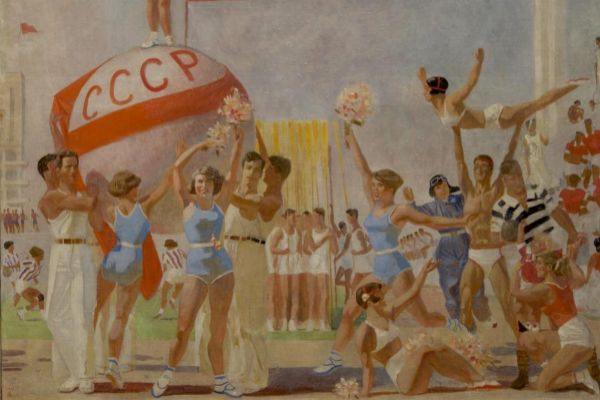The scene takes place at the opening of the last exhibition of the Manege Museum in St. Petersburg, an old horse enclosure of the former Imperial Guard, which offers until January 19 a vision of the work of two prominent painters of the Soviet era: Alexander Deineka and Alexander Samojvalov. Among visitors and art critics, a child makes his way by pointing with the index finger the acronym written in one of the pictures .
- Mom, what is URRS?
- A country.
- And where is?
- It was here.
- In St. Petersburg?
- Yes ... But hey, that's history.
In total, 300 works from 37 museums and 9 private collections. Especially paintings, but also sculptures and photographs: materials to decipher a country that no longer exists. There are more and more Russians who did not see it with their own eyes and for the rest the memory contains the mist of personal experiences. The show goes to the root, to the two artists who shaped the official imagery of a country that in a few years invented itself : from the economic model to the aesthetic. Communism edged the avant-garde in favor of socialist realism, it was the most appropriate format to reach the masses that the only possible power was the dictatorship of the proletariat.
Alexander Deineka and Alexander Samojvalov are among the most prominent figures of socialist Realism. They portrayed the wide mobilization of World War II, work in the USSR - with women and men building a new country - and body worship in sports. "These issues show the involvement of people in the nation's transformative process," explains Semion Mikhailovsky, the head of the exhibition.
The exhibition presents two similar but different artists. «One, Deineka, linked to Moscow; the other, to Leningrad. They don't know each other very much, but they end up doing a similar art and that creates a great visual culture made by the artists themselves, ”says Christina Kiaer, a specialist in Soviet art and author of the book Imagine No Possessions on this movement. " We are not talking about Stalin saying in his office what to paint , the creators sent in the Artists Union, defined how to be in line with what the party wanted."
Deineka's work is essential to understand the main artistic trend of the USSR. His biography defines the sign of those times. Raised in a family of former peasants, his father was a railroad and when the revolution explodes the artist is 18 years old. Like many young people of the time, he is attracted to Lenin's ideology. After the October revolution he joined the Red Army, but as a painter, posterist or photographer.
Deineka had a much greater influence than the rest. "He was the one who really invented the Soviet body and shaped it : bodies where there is nothing left, using fair lines, very square, with arms outstretched ... and created a trend," Kiaer explains at the doors of the show trying to imitate the positions of those Soviet models. « The big difference between the two is how they paint women . Deineka's case is more interesting, they are less sexualized, because it called into question the capitalist or traditional sexualization of women ». Instead Samojvalov "paints breasts everywhere, his painting of women building the subway is like Playboy."
Samojvalov was born in 1894 in the Russian Empire and was greatly influenced by the spherical perspective and the point of view of more classical Russian art, in the shadow of his own introspection. This can be seen in militarized Komsomol, which portrays the military training of several Soviet young people in charge of the youth of the party. The scene was found when he was in a boat. "His characters appear almost frozen in a state of metaphysical uncertainty," explains Mikhailovsky.
When the State was the Big Brother
Drop down
Plastic artists had less state pressure than in other disciplines. «Something different happened in literature and in cinema. Stalin was very interested and the film industry was much more controlled. because obviously it is much more expensive, ”says Kiaer. Literature was even more controlled "because anyone can feel an expert and Russia is a very reading country." Both artists in fact collaborated in the illustration of books of the time. Here comes into play the cultural character of the Russians: «His is not a visual culture, but a reading one. They had no oil painting before the 17th century. His tradition was another: icon painting, ”adds Kiaer. The Soviet government was not so interested in the visual, "but the Bolsheviks were very readers." That is why many more writers than painters died during the Stalinist terror.
According to the criteria of The Trust Project
Know more- culture
- art
- Russia
- Painting
Art They take their place at the Prado Museum
Arte200 anniversary of the Prado Museum: Goya, sniper of drawing against atrocious Spain
CultureHow to see the painting classics inside

